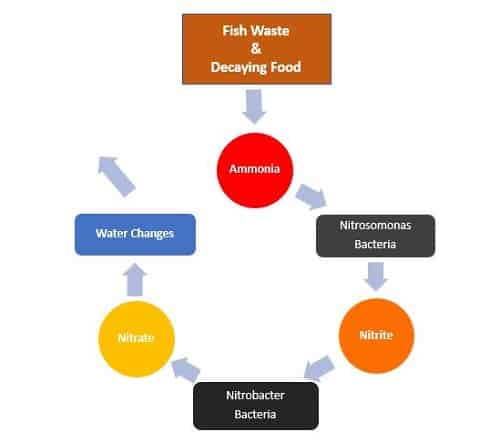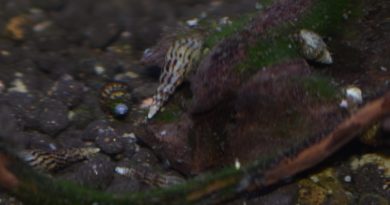The Nitrogen Cycle in Aquariums
The Nitrogen Cycle in Aquariums or New Tank Syndrome as it is commonly called is a process of building up a colony of beneficial bacteria in your tank. These bacteria will break toxic fish waste down into substances that are less harmful to your fish. Failure to understand the nitrogen cycle is a major contributing factor to the loss of fish.
Cycling a new tank usually takes from six to eight weeks to complete. However, there are products and tricks to speed up this process.
There are two kinds of essential bacteria needed to maintain a healthy aquarium. The first kind of bacteria breaks ammonia down into nitrites, and the second kind breaks the nitrites down into nitrates. Nitrates are then removed from your fish tank by performing regular water changes.

The water readings of a healthy aquarium are:
- Ammonia: 0 ppm
- Nitrite: 0 ppm
- Nitrate: < 40 ppm
Cycling your aquarium can be done in two ways, fish-in or fishless cycling.
Fish-in Cycling an Aquarium:
Fish-in cycling is presently the most common method and is the way I have always used for cycling a tank. This is done by adding a small number of fish to your aquarium initially and building up to your required stock level over time. The fish waste they produce contain a continuous source of ammonia which is required to cultivate and feed the growing bacteria.
There are a number of ‘bacteria in a bottle’ products on the market which can be used to make fish-in cycling safe for your fish and will speed up the nitrogen cycle process and avoid new tank syndrome.
Another great way to speed up the cycling process is to get some seeded material from a healthy, established aquarium. The best seeding material comes from a filter as that is where the vast majority of bacteria live. However, even a handful of gravel or some rocks from an established tank will help.
Fishless Cycling an Aquarium:
Fishless cycling as the name implies is done without fish in the tank. Instead of fish producing the waste, you will regularly dose the tank with pure ammonia until a colony of beneficial bacteria is established. After the cycle is complete a large water change is done and fish are added at that point.
In an ideal scenario, fishless cycling is the best way to cycle your aquarium as there is no danger to fish. However, not many people would be willing to look at an empty tank for the amount of time needed for the cycle to complete, especially with proven bacteria in a bottle products being easily available.
How to get started cycling your aquarium?
First of all, it’s always a good idea to test the parameters of your tap water to give you a baseline to work from. You may also want to check on the type of chemicals that are used by your water supplier to treat your water. For instance, if chloramine is used the water may have an ammonia reading of 1.0ppm or 2.0ppm straight from the tap. This information can usually be found on the water supplier’s website.
Always use a dechlorinator when adding tap water to your aquarium. The chemicals used to treat tap water are harmful to fish and the bacteria you are trying to cultivate. Even if you are only carrying out a 20% water change add the amount of dechlorinator needed to treat the full tank.
The cycle starts when a constant supply of ammonia is introduced into the aquarium, either in the form of fish waste or drops of pure ammonia. At this point, you can also add the bacteria in a bottle product, ensure that you dose according to the manufacturer’s instructions. As the ammonia level in the water increases some new bacteria will begin to grow in the tank. These bacteria will feed on the ammonia and the ammonia level will begin to drop.
The ammonia eating bacteria produce another waste product that releases nitrite into the water. As the nitrite level in water starts to increase another type of bacteria will then start to grow. These new bacteria feed on nitrites causing the nitrites to drop.
The nitrite eating bacteria produce their own waste products which give off nitrates. Even though nitrates are not as harmful to fish, they should not be allowed to build up in the tank. Regular partial water changes are needed to keep the nitrates low.
It is important to avoid overfeeding your fish while getting your tank cycled. Allow time for your tank to stabilize first before trying to power feed your fish. Vacuum out any uneaten food and fish waste as needed.
Remember ammonia and nitrites are very toxic to fish. The key for success with fish-in cycling is testing the water regularly, and taking action quickly in the form of water changes and reduced feedings if problems occur.
How do I know when my aquarium is cycled?
Your ammonia levels will gradually drop to 0ppm and give way to higher nitrite levels. Nitrite will lower to 0 ppm and nitrates will start to rise. When you consistently test 0ppm for ammonia & nitrite and have a positive reading for nitrates, you have a cycled tank.
After your tank is cycled continue to test your water parameters regularly and perform weekly partial water changes to remove the nitrates. Slowly build up your fish stock, remember that each new fish will add more ammonia and time should be allowed for the bacteria to catch up.
Thanks for reading. If you found this article helpful, don’t forget to share 🙂



